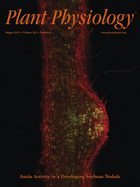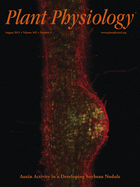
Cover image

On the Cover: The roles of auxin in symbiotic nodule development are not clearly understood. In this issue, Turner et al. (pp. 2042–2055) show that there is very low auxin activity during nodule formation in soybean (Glycine max) and that it changes in a spatiotemporal manner during subsequent nodule development. By manipulating auxin sensitivity using microRNAs, they demonstrate that hypersensitivity to auxin inhibits nodule development likely via modulation of cytokinin sensitivity. Their results suggest a feedback loop involving auxin, cytokinin, and miR160, that governs nodule development. The cover image is a laser confocal optical section of a developing soybean nodule expressing the auxin-responsive marker gene construct, DR5:tdT. Cotransformation of a constitutively expressed sUbi:GFP construct helped distinguish autofluorescence on the root surface (appearing bright red) from marker gene expression (appearing yellowish-red). Photo credit: Narasimha Rao Nizampatnam.
Volume 162, Issue 4, August 2013
ON THE INSIDE
On the Inside
EDITORIAL
Plant Physiology Welcomes Its New Topical Reviews
TOPICAL REVIEWS
The Agony of Choice: How Plants Balance Growth and Survival under Water-Limiting Conditions
A comprehensive overview is presented of the effects of water limitation on growing shoot tissues, with a focus on molecular mechanisms and networks restricting growth, adaptations for maintained growth, and the molecular interplay between growth and stress tolerance with potential for crop engineering.
Improving Photosynthesis
Photosynthesis is the basis of plant growth, and it is argued that improving photosynthesis can contribute toward greater food security in the coming decades as world population increases.
BREAKTHROUGH TECHNOLOGIES
Measuring Arabidopsis Chromatin Accessibility Using DNase I-Polymerase Chain Reaction and DNase I-Chip Assays
Differential DNA accessibility, which is established by local chromatin environments and strongly affects gene expression, can be assayed utilizing DNase I digestion coupled to detection by PCR or on tiling arrays.
RootNav: Navigating Images of Complex Root Architectures
RootNav is a novel image analysis tool that facilitates the accurate recovery of root system architectures from images.
An Improved Simplified High-Sensitivity Quantification Method for Determining Brassinosteroids in Different Tissues of Rice and Arabidopsis
A simple and high-sensitivity quantitation strategy based on simplified extraction, purification, and derivatization processes enables quantification of brassinosteroids in small amounts of plant tissue.
RESEARCH REPORTS
Export of Salicylic Acid from the Chloroplast Requires the Multidrug and Toxin Extrusion-Like Transporter EDS5
The synthesis of the immune signal salicylic acid is abolished by a mutation in a hitherto unknown transporter protein. This article describes the transporter localization at the chloroplast and its function in the export of salicylic acid from the chloroplast.
Article
BIOCHEMISTRY AND METABOLISM
Dynamic Adaption of Metabolic Pathways during Germination and Growth of Lily Pollen Tubes after Inhibition of the Electron Transport Chain
Pollen metabolism shows a dynamic transition from pollen grain germination to pollen tube growth and can quickly compensate inhibition of the oxidative phosporylation.
Transcriptomic and Metabolic Changes Associated with Photorespiratory Ammonium Accumulation in the Model Legume Lotus japonicus
Transcriptomic and metabolomic analysis of a plastidic glutamine synthetase mutant shows a coordinate repression of photorespiratory genes and accumulation of several key metabolites.
Simultaneous Application of Heat, Drought, and Virus to Arabidopsis Plants Reveals Significant Shifts in Signaling Networks
Arabidopsis plants exposed to triple stress are characterized by transcript responses not predictable from single stress treatments that significantly alter the expression of genes involved in signaling and defense processes.
A Rice Virescent-Yellow Leaf Mutant Reveals New Insights into the Role and Assembly of Plastid Caseinolytic Protease in Higher Plants
Disruption of the OsClpP6 gene causes a virescent-yellow leaf phenotype, demonstrating an important role of caseinolytic proteases in regulating chloroplast biogenesis and leaf development in rice.
Pepper Arginine Decarboxylase Is Required for Polyamine and γ-Aminobutyric Acid Signaling in Cell Death and Defense Response
Pepper arginine decarboxylase, CaADC1, which interacts with Xanthomonas effector AvrBsT, induces increased polyamine and γ-aminobutyric acid levels, and triggers nitric oxide and reactive oxygen species bursts, ultimately leading to plant cell death and defense responses.
CELL BIOLOGY
Following Vegetative to Embryonic Cellular Changes in Leaves of Arabidopsis Overexpressing LEAFY COTYLEDON2
A transcription factor triggers embryonic characteristics in Arabidopsis vegetative organs.
HAPLESS13, the Arabidopsis µ1 Adaptin, Is Essential for Protein Sorting at the trans-Golgi Network/Early Endosome
HAPLESS13 is the Arabidopsis 1µ adaptin protein and affects multiple developmental and cellular processes by sorting membrane proteins, including auxin and brassinosteroid signaling elements, at the trans-Golgi network/early endosome.
Visualization of BRI1 and BAK1(SERK3) Membrane Receptor Heterooligomers during Brassinosteroid Signaling
Initiation of brassinosteroid signal transduction involves a small number of preassembled BRI1-BAK1(SERK3) heterooligomers.
Identification of a New Class of Lipid Droplet-Associated Proteins in Plants
A new class of lipid droplet-associated proteins in nonseed tissues is identified by integrated omics approaches.
ECOPHYSIOLOGY AND SUSTAINABILITY
Characterization of AtSTOP1 Orthologous Genes in Tobacco and Other Plant Species
Diverse land plant species possess similar proteins that function in transcriptional regulation of aluminum tolerance.
Coordination between Apoplastic and Symplastic Detoxification Confers Plant Aluminum Resistance
Plants must coordinate exclusion and internal detoxification to reduce aluminum toxicity effectively.
Ocean Acidification Alters the Photosynthetic Responses of a Coccolithophorid to Fluctuating Ultraviolet and Visible Radiation
Ocean acidification and fast mixing or fluctuation of solar radiation could act synergistically to lower carbon fixation by G. oceanica, though ocean acidification may decrease UVB-related photochemical inhibition.
Nitrogen Stress Affects the Turnover and Size of Nitrogen Pools Supplying Leaf Growth in a Grass
Nitrogen stress has strong effects on the size and turnover of nitrogen pools supplying leaf growth of a grass but does not alter the relative contributions of currently assimilated and remobilized nitrogen for leaf growth.
GENES, DEVELOPMENT, AND EVOLUTION
Disruption of Fumarylacetoacetate Hydrolase Causes Spontaneous Cell Death under Short-Day Conditions in Arabidopsis
Disrupting fumarylacetoacetate hydrolase leads to cell death in Arabidopsis, indicating that the Tyr degradation pathway is essential for plant survival under short-day conditions.
Brassinosteroid Regulates Seed Size and Shape in Arabidopsis
Brassinosteroid regulates Arabidopsis seed size and shape by transcriptionally modulating specific seed developmental pathways.
ERECTA Family Genes Regulate Auxin Transport in the Shoot Apical Meristem and Forming Leaf Primordia
ERECTA family receptors are involved in the regulation of phyllotaxy and leaf initiation.
SIGNALING AND RESPONSE
Cross-Repressive Interactions between SOC1 and the GATAs GNC and GNL/CGA1 in the Control of Greening, Cold Tolerance, and Flowering Time in Arabidopsis
The transcription factor SOC1 is regulated by two GATA transcription factors for the control of flowering while the GATAs are controlled by SOC1 to control greening and cold tolerance.
The Alteration of Plant Morphology by Small Peptides Released from the Proteolytic Processing of the Bacterial Peptide TENGU
A bacterial peptide effector undergoes proteolytic processing in plants and releases small peptides that alter plant morphology.
Transient Transcriptional Regulation of the CYS-C1 Gene and Cyanide Accumulation upon Pathogen Infection in the Plant Immune Response
The analysis of a mutant in the main enzyme responsible for cyanide detoxification, the mitochondrial β-cyanoalanine synthase, uncovers a new signaling role for cyanide in the plant response to pathogens.
Identification of Genes Involved in the Response of Arabidopsis to Simultaneous Biotic and Abiotic Stresses
Arabidopsis responds to simultaneous water stress and nematode infection by activating a unique program of gene expression that is distinct from the response to individual stresses.
Ectopic Expression of miR160 Results in Auxin Hypersensitivity, Cytokinin Hyposensitivity, and Inhibition of Symbiotic Nodule Development in Soybean
Analysis of symbiotic nodulation indicates low auxin activity and auxin hypersensitivity during nodule initiation, and regulatory feedback with auxin and cytokinin during nodule development.
The HERBIVORE ELICITOR-REGULATED1 Gene Enhances Abscisic Acid Levels and Defenses against Herbivores in Nicotiana attenuata Plants
By enhancing abscisic acid levels, a novel herbivore elicitor-regulated protein plays an essential role in efficient defense of metabolite accumulation against herbivores in plants.
Lifting DELLA Repression of Arabidopsis Seed Germination by Nonproteolytic Gibberellin Signaling
GA signaling controls seed germination in the sly1 mutant background, in which DELLA repressors cannot be destroyed by the ubiquitin-proteasome pathway.
SYSTEMS AND SYNTHETIC BIOLOGY
Elucidating Rice Cell Metabolism under Flooding and Drought Stresses Using Flux-Based Modeling and Analysis
A metabolic/regulatory network of rice incorporates two important tissue types, germinating seeds and photorespiring leaves, is validated through experiments with rice suspension cultures, and applied to analyze metabolic capability under flooding and drought conditions.


